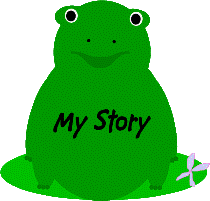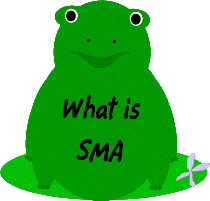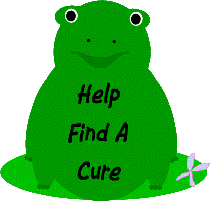|
About SMA |
|
|
|
Quick Facts About Spinal Muscular Atrophy (SMA):
|
|
|
|
Additional Information on SMA |
| What is Spinal Muscular Atrophy (SMA)? |
| Types of SMA |
| What is SMA in Kids Terms? |
|
|
|
What Is Spinal Muscular Atrophy (SMA)? Spinal Muscular Atrophy (SMA) is a motor neuron disease. The motor neurons affect the voluntary muscles that are used for activities such as crawling, walking, head and neck control, and swallowing. It is a relatively common "rare disorder": approximately 1 in 6000 babies born are affected, and about 1 in 40 people are genetic carriers. SMA affects muscles throughout the body, although the proximal muscles (those closest to the trunk of oneís body - i.e. shoulders, hips, and back) are often most severely affected. Weakness in the legs is generally greater than in the arms. Sometimes feeding and swallowing can be affected. Involvement of respiratory muscles (muscles involved in breathing and coughing) can lead to an increased tendency for pneumonia and other lung problems. Sensation and the ability to feel are not affected. Intellectual activity is normal and it is often observed that patients with SMA are unusually bright and sociable. Patients are generally grouped into one of four categories, based on certain key motor function milestones. |
|
|
|
Type 1 children are diagnosed usually before 6 months of age, more often before 3 months of age. Symptoms may even start in the womb. Many mothers later recall the baby not moving as much the last month or so of pregnancy. They are not able to hold up their heads, roll over, crawl, sit up without support, or walk. All of their muscles are extremely weak, with the weakest muscles being the legs, upper arms, and neck. Their chest may appear concave, or very skinny at the top, with a big belly. Bell-shaped. SMA affects all muscle systems as well including sucking, swallowing, digesting food, and excretion. Constipation is a common problem as is being able to control excessive drooling (secretions) and getting proper nutrition and calories for proper weight gain. A common cold can easily turn into pneumonia which is what usually takes the lives of these children, along with "respiratory failure" or when they no longer have the lung or chest muscles to be able to breathe on their own. Two major decisions must be made with Type I children...whether or not to insert a feeding tube to prevent pneumonia and prevent starvation when they have lost their ability to suck or swallow; and whether or not to put them on a ventilator or other breathing machine when they experience respiratory failure. Current statistics show that the average lifespan of a child with SMA Type I, not put on permanent ventilation or "life support", is only 8 months of age, with 80% dying by the age of one, and the majority of the rest dying by age 2. HOWEVER, these statistics are not a hard and fast rule. Each child is affected so differently by SMA that they do not all follow the same path or progression. Also, as more is learned about SMA, the lifespan of a Type 1 child can be lengthened depending on the severity of the symptoms for each particular child. Last but not least, the line between each Type of SMA is not clearly defined, and it is common for a child to exhibit patterns of two types, thus confusing the issue of "life expectancy" for that child. Type 1 children most often have very little leg movement, very little upper arm movement. Many times their hands remain fisted and their hands/wrists are turned the "wrong" way. The physical characteristics that often "gives them away" to having SMA is a bell shaped body, legs that stay in the "frog" position, moving the arms from the elbows down only, and the head tilted to the side because of lack of neck muscles. They often have bright, expressive faces and eyes. Type 2 children are diagnosed before 2 years of age, usually more like 15 months. These children are usually able to be in a sitting position without support, but often can not get there by themselves. They can sometimes crawl with bracing and therapy, and on occasion may stand with braces. Feeding and swallowing problems are not common in Type 2 children, though they are still possible. They will usually never walk. The lifespan of a Type 2 child varies so widely, there isn't one! They could pass away at an early age or they could live well into adulthood. As with all forms of SMA, weakness increases over time. Type 3 children are diagnosed between 18 months of age and early adolescence. In the beginning these children are able to stand and walk but usually have difficulty doing so. They typically have a normal lifespan; however, as with all forms of SMA, weakness gets progressively worse and they usually will be wheelchair bound. Type 4 SMA is an adult SMA, with symptoms beginning around age 35. They also usually have a normal lifespan; though, as with all forms of SMA, weakness gets progressively worse. *from SMA Support |
|
|
|
You have just heard about SMA and are now
wondering what that is. SMA is a short way of saying a really
long word. SMA stands for Spinal Muscular Atrophy, which is why
everyone just says SMA. SMA is like an illness that you canít
catch, so donít worry. People are born with SMA. Kids with SMA
are just like everyone else, they just do things differently.
Kids with SMA use wheelchairs to move. Kids with SMA donít have
a lot of muscles. Think about how big your muscles are right
now and now imagine what it would be like if you didnít have
any. When you are a baby, you have tiny muscles that donít work
well but they grow bigger as you get older. In kids with SMA
their muscles donít grow. They have little muscles because
their muscles didnít get the message from the brain to grow.
Thankfully, the brain isnít a muscle so kids with SMA are smart
and love to talk and laugh and sometimes even tell jokes.
Everything you do involves muscles like how you eat, how you
move, and even how you talk. Any movement is hard when you have
no muscles, so doctors are trying to find a way to make the
muscles grow bigger. You can help by raising money to help the
doctors find a medicine to help the muscles grow bigger and
stronger so that kids with SMA can be just like you.
|
|
You're Listening to
One of CJ's Favorite Songs |

 SMA is the #1 genetic killer of children under the age of
2.
SMA is the #1 genetic killer of children under the age of
2.







